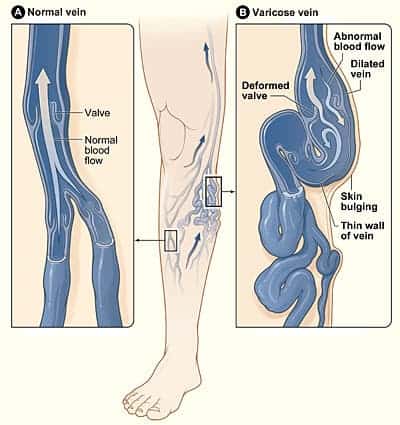While they are often causes of embarrassment, varicose veins are more than just a cosmetic problem. They are also potentially indicative of significant health problems as well. They are often a sign of circulatory disease. Thankfully, severe varicose veins and their related problems are not particularly common and there are methods that you can use to treat them.
Recognizing the Symptoms

Most of the time, the biggest symptom of varicose vein development is visible. The vein swells up and you notice the blue line running across your skin. In severe cases, the veins may even bulge outward causing cord-like swellings on your legs.
Not all are visible though! According to experts at the Intermountain Vein Center of Utah, you can develop these veins within your muscles as well. Feelings of heaviness in your arms, legs, and feet are a signal that something is awry. Aches and pains in these areas are also symptoms. If you experience itching near a vein, it may be a sign it is becoming varicose. Skin ulcers near your ankles are a sign that your problem is severe.
Getting Treatment
Your first step in treating your varicose veins should always be to consult your primary care physician. Your doctor can examine you and run initial tests to see whether your veins are simply a product of age, a cosmetic problem or are indicative of something more serious. If the problem is medical in nature, your doctor will then likely refer you to a specialist who focuses on veins and the cardiovascular system to help you find the right treatment for your situation.
Thankfully, the treatment rarely requires extensive medical procedures or hospital stays. Here are just some of the new treatments (and newly recognized treatments) that can help reduce the appearance and threat of varicose veins.
Self Care
Common thought used to be that varicose veins were simply something that happens. Now doctors know that they are often preventable and even treatable through self care. In this case, self care means wearing clothing that fits properly (isn’t too tight), eating healthfully, losing weight and getting up and moving around/changing position often are all ways to keep your blood flowing smoothly so that it doesn’t pool and create varicose veins.
Note: the exception to the “no tight clothing” rule is compression gear. Compression stockings, etc. steadily squeeze your body to help blood move more efficiently.
Varithena
Varithena was approved by the FDA in 2013. This is a drug developed by pharmaceutical developers in Britain and, outside of self-care and compression gear, is one of the most minimally invasive procedures for varicose veins available. The drug is a foam that is injected into the patient and dissolves the vein. This eliminates the need for surgical intervention or removal.
VenaSeal
The most recent development in varicose vein treatment is VenaSeal. Approved in 2015 by the FDA, VenaSeal is a procedure that uses adhesive to cut off blood supply to the affected vein. The adhesive is inserted via a catheter and the entire procedure can be performed in a doctor’s office. According to its developers, patients can go back to their daily activities right away instead of having to take it easy and wait to recover.
Prevention
While not exactly a new treatment, or even a treatment per se, we did want to take a moment to talk about the steps you can take to prevent varicose veins from happening in the first place. And they are, most of the time, a preventable problem.
Prevention looks a lot like the self care you use to reduce the appearance and hopefully heal varicose veins after they appear. Wear properly fitted clothing. Eat well. Move around. But if you really want to prevent varicose veins and similar problems, you need to kick the self care up a notch. Put together a healthy diet and exercise plan so that you can lose weight if you are overweight or obese. Wear clothing that fits properly. Don’t spend all day standing or all day sitting. Work on keeping your blood pressure and cholesterol levels low.
Varicose veins do not have to be a permanent problem. There are many ways to treat them and prevent them, including the methods we’ve listed here.






